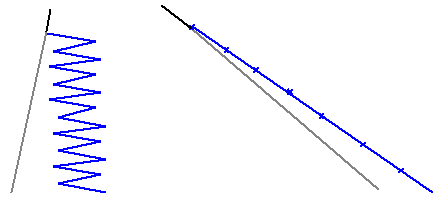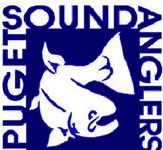Jigging for Salmon
Jigging is a term
used to fish whereby you attach a weighted lure in the end of the line, let it
down, raise the rod tip, let it back down, and repeat again. Well, it is not really that simple, there
are a few other ingredients in the mix.
Jigging works best when you can locate a concentration of
bait / or fish. Since you do not cover a lot of water this way as you
locate the fish with your sonar, shut off the motor & try to hover over
them. The wind & tide may move you off your target, & at
times it may behoove you to drop an anchor. Water depth is not
critical, but you will have to use a heavier jig the deeper that you go.
We might clarify here in saying that this is basically vertical
jigging. This means that your line HAS to be as straight up &
down as possible. The reason is that when your jig on the raise of
your rod tip will of course come up a few feet, they you drop the tip the design
of jig allows it to level itself, & allows this jig to sea-saw back &
forth fluttering down. This fluttering motion is what attracts the
fish & entices a strike. If the line angle gets enough so that when
you drop the rod tip, the jig can not drop vertical, but still at the angle of
the line, you get no fluttering & therefore way less fishy enticing action
to the lure.
Use the lightest jig you can (usually a 2 oz.). If
& when the drift or current gets more & you can not jig vertically then
you will have to go to a heavier lure, or use your kicker motor to position you.
In the illustration below, the gray line represents the
upward pull with the blue the jig's path of falling. The LH represents a
vertical jig being raised & then dropped with the jig laying somewhat
horizontal & fluttering as it descends. The RH illustration will
be if the drift has your line angle so much that when you drop the rod tip, the
current merely pulls the jig rearward with little fluttering. These
jigs need to flutter to make a bait-fish action.
|
Jig descending patterns
|
|

|
Rod: To do it right, the gear comes into play
every bit as much in this method as trolling or mooching, however totally
different equipment is used. You will
probably want to use shorter rods with stiff butt sections and fast taper
sensitive tip. Some prefer a 7’ to 7’
9" length. These rods are different than a trolling or mooching rod
& have more backbone. A backbouncing rod like the G. Loomis
HSR-932C or Lamiglas Puget Jigger model G1302-T work well.
Reel: Since you are cranking a lot more here than in any
other method, you need a reel with a retrieve ratio of at least 4 to 1, with
upwards to 5 to 1 being better. You
don’t usually need a large reel, so an Ambassedeur 5500, Diawa Millionare 35,
Shimano Bantam 50 or Shimano Triton 100G will all work fine. However since the
fish may be suspended off the bottom, a line-counter reel like the Shimano
Tekota 400LC or Cabellas DM20 will prove very
beneficial to help you keep the lure within the strike zone. These
line counter reels may add a few ounces of extra weight, but under the right
conditions may improve your catch. Which ever reel you pick, it does need
to have a good drag system.
It is about impossible to effectively vertical jig with a
spinning reel & yet be ready to set the hook on a slack line bite.
Line: You may want to fill the spool
about half full with 20# mono, & then top it off with 125 yards or so of
one of the new Spectra lines in about 30# to 50# size. You also need to be sure this spectra line is wound onto the spool very tight, as
if not, when it gets wet & then dries, it seems to loosen enough so as to
create line cutting into the edges & creating a stoppage of the
spool. This WILL equate to lost fish if they are running when
the spool comes to a stop. This is the reason for the mono backing as it helps
eliminate this situation & you probably do not need more than much over 100
yards of line anyway as if you have to chase a fish, and your boating situation is
such that you should be able to readily chase the fish.
This type of fishing is where the spectra type lines really pay
off, because it has no stretch, and since it is a very small diameter, allows
you to feel the take on the jig, plus reaching the bottom with less
weight. You might consider using a 6’
shock leader of mono attached to a ball bearing swivel. This will help avoid pulling the hook out of
the fish’s mouth during a hook set. It
also may help to camouflage the line to the lure.
It helps if you add about 36" or so of 20#
monofilament line as a leader tied to a small Sampo ball bearing swivel.
On the terminal end of this monofilament attach a small snap. The use of a
snap will allow you to change the lure more easily & therefore more often if
conditions change, or you are not getting hits. This mono acts as a
short shock cord & also helps eliminate the possibility of the limper
spectra line from getting tangled with the jig's hook on the fall.
Lure: If you are not sure what bait
size is below you, use
the smallest jig you can get away with and still reach bottom. If after you catch a fish open it up &
observe the stomach contents. This may
help you select a jig to “Match the Hatch”.
Brands of proven jigs are Crippled Herring, Point Wilson Dart,
& Grim
Reaper to name a few. Even the heavier
Coyote spoons have proved effective. Colors of
proven jigs may be green, blue/silver or white. Many fishermen will remove the existing triple hook & replace with a Siwash hook. At this time place a barrel swivel between
the hook & the jig, this will help keep the fish from using the leverage of
the jig, the fish rolling & pulling
the hook loose.
Some of these lead jigs you may read on the package that
you can bend them for different results. Well this may be so, but if you
put a bend as if you were if you were trolling allowing the lure to rotate, this
negates much horizontal fluttering action.
| Crippled
Herring |
 |
Hooks: Use SHARP
hooks. The rule of thumb on hooks is that terbles
may have more hook ups, but a single Siwash hooks deeper and loses less fish. Even if the lure comes with a Siwash hook, it
may be best to replace it with a slightly larger size for better hooking
ability. In the State of Washington, just be sure you
are using barbless hooks, or at least pinch the barb over.
Scent: Yes, put scent on the lure, it doesn't have to be a lot, as if
your jig has much contact with rocky or sandy bottoms, this sticky scent may
well attract what it can pick up off the bottom. Smelly Jelly is a good one, a couple
of the flavors used can be Anchovie or Herring/Anis, but about anything can be
used as these fish are hitting the lure with little reaction time, so scent
probably is a masking scent to cover your own smell.
Method: You need to find the bait
school or preferably a salmon school,
spool out line & jig semi-slow. Jig
your rod in about 2 foot motions, following the jig with the rod tip as it
drops. This keeps you in contact with
the lure at all times. There is no need to
jerk it the full rod length, as you will probably be pulling it so far that the
fish can not keep up with it.
When searching for fish & you may want to cover
say 30' of the bottom water, when you get to
the bottom, jig it up a couple of feet, let it fall back, raise it up 4 feet
& let it fall back 2, raise it another 4’ & fall back another 2’ &
work your way up past the bait. Then
start over by going back down again if you are still in the bait fish. When the
fish grabs the lure, it is just like it hit bottom and the line went
slack. The bite is almost always when
the jig is fluttering down like a wounded baitfish. Try to keep the rod tip low to the water so you will have room to
make the hookset. Now comes a critical
situation. As a novice, you will probably not
be able to detect a slack line hit on the fall, but if you are only raising say
2', you may well detect the fish on the next upward motion. Be well
prepared to set the hook at the slightest deviation of normal.
If all else fails & the wind may be pushing you out of
the fish concentration, drop your anchor & increase the weight of the jig. Yah, I know this may not be
fishing as vertical as you may like, but it is at least putting you over the
fish more time than drifting off & running back all the time.
If you have one of the newer line-counter reels then you
can set it & concentrate on the exact level the fish are at. If you
are using an conventional level wind reel, then you can estimate closely your
depth by grabbing the line at the reel & stripping it out to at least the
first rod guide. This is usually about 24", so you can get a pretty
good idea of the amount of line pulled out. In conjunction to this
when you start stripping if you glance down & visually locate the location
of the level wind, & count the number of pulls/feet that it takes to move
this level wind head completely over & back to where it was when you first
started. By doing this, you can then later come close by not stripping,
but by just counting the passes of the level wind head. A Shimano Triton
100G lets out about 10' per complete pass with a full spool.
And as usual the fish will hit when you least expect it,
so be ever vigilant. You may be letting line out just to get to the bottom
in say 90', but your line hesitates at 40', SET THE HOOK.
Tips : If your
boat has a high cabin or a flat bottomed sled type boat where the wind can push
the boat faster than a ordinary drift, it might be beneficial to try a drift
sock or even 2 off the stern. This could help slow your drift down
& help maintain a more vertical line angle by keeping you in position
longer.
If there are other fishermen near, watch & see what
they are using & how they are using it if they catch fish.
Exceptions : Buzz Bombs
will work in vertical jigging, but they are better to be cast out & reeled in, hesitate & reel
again allowing the lure to sink slightly on each hesitation. These lures rotate on the line
& have a totally different action. When using them be sure to use the
rubber bumper between the lure & the hook which is supplied in the
package. One thing to observe is that there is a front & rear of them,
READ on the lure which end is FRONT.
Where: For best results, jigging only works when the fish
are stacking up in concentrations, like a river mouth, or on the lea side of a
point when they are
targeting bait fish like herring or candlefish.
Other
Important items: One of the
most important items here will be a good fishfinder. You may have noticed I said fishfinder not depthfinder.
Sure you need
to know the depth of the water, but more important you need to know where the
bait is, as where you find the bait, that is also where the targeted fish are
more likely to be. Any sonar can give you the bottom depth, but
you really need to have one that can be adjusted to show actual fish & bait
as well.
You do not cover
water like trolling when you jig, so you will need to be on top of
concentrations of baitfish, after all, you are trying to imitate baitfish with
your lure. Without this you are just
getting upper arm & body exercise.
Here you will
probably be at the whims of the tide or wind, so fishing tide change at slack
tide is way preferable than fighting a full running current.
Copyright © 2004-2006 LeeRoy Wisner All Rights Reserved



